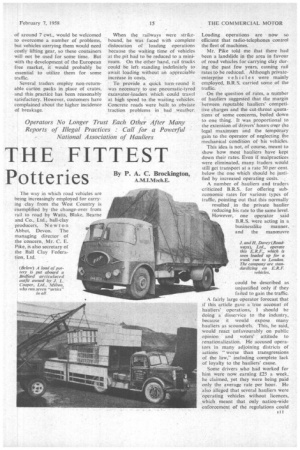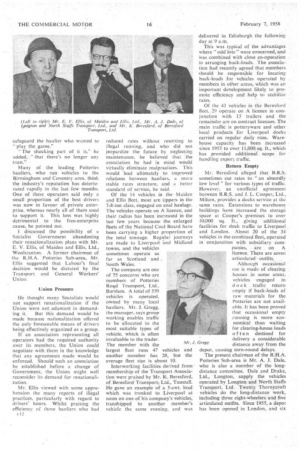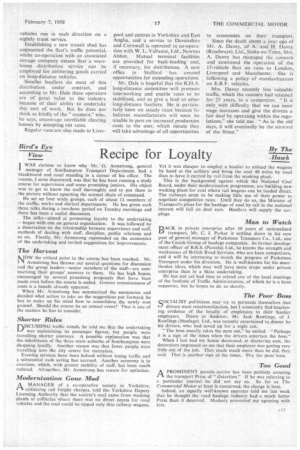SURVIVAL OF THE FITTEST In The Potteries
Page 58

Page 59

Page 60

Page 61

If you've noticed an error in this article please click here to report it so we can fix it.
/T was often .emphasized by the Canadian Trade Mission which visited Britain at the end of last year that Self-criticism is a national failing of this country. Visiting the Potteries for the second time in three years to survey transport operations, I found the outspoken criticism by private hauliers of other operators could obscure their joint achievements if heard by outsiders.
Perhaps the people of the Potteries may be described as typical of the majoritywith regard to self-criticism —but "more so:" One leading haulier assessed his progress'in tents of cwr,. rent rates, compared with those which would probably have been 'charged by British Road Services if they had continued to enjoy a long-distance monopoly. He thought rates were at least 30 per cent. lower than they would have been if there had been no denationalization, so hauliers were "working harder for the same profit"
But this was intended by the Conservatives, who appear far better businessmen than most of the Socialists.
Private hauliers, said this operator, wanted free competition, but now they were calling for protection because they were incapable of pro tecting themselves. They complained of "other men" running illegally, but failed to inform the authorities. They dealt with unreliable clearing houses, and then wondered why their rates were low.
Two years ago, I reported that in the [JO Potteries, manufacturers were well satisfied with the efficiency of B.R.S., following a short period of chaos. Commenting on developments in the intervening period, a representative of a number of local manufacturers told me that the State undertaking was now providing an even better service, par ticularly for portwise traffic. B.R.S. had established a special department for handling export consignments, and the staff were performing a iirst-claSs job.
Ample warehouse capacity is essential for shipping consignments, -partly because manufacturers often cannot expand their own premises for large storage accommodation. The credit squeeze and othertrading conditions have tended to reduce the Size of consignments and to increase the frequency' of delivery runs with finished products often timed to tight schedules.
According to a number of manufacturers, private.. hauliers are now giving an imprOved service for the delivery of finished products—Much of which is carried under contract—and they have a larger share of raw .material traffic. This has Offle about
despite a marked improvement in the rail service forraw materials, which is
the outcome of further u.s.e. of mechanical handling.
Clay for the pottery manufacturers is supplied by concerns in Cornwall and Devonshire, and both road and rail rates are now highly competitive
with the shipping rate. Much of the clay is shipped round the coast to Runcorn and by canal to Western Point, where it is collected by road vehicles. On average the round trip by road to the suppliers exceeds 500 mile-s Delivery by road to home markets is hampered by the large number of drops, which add substantially to the operator's epsts. The railways are given a fair proportion of this traffic. but their charges for returning empty potteryware crates are said to be prohibitive. it is possible that this may initiate a transfer of rail traffic to road. However, there were no criticisms about railway losses or breakages.
Of the two or three types of collapsible crate, none is readily adaptable to the requirements of the trade, according to the Majority of makers t met. . One chinaware manufacturer pointed out that it was necessary to return straw with the crate, so it really had no advantages.
The dropsided Continent at container.• which hias a Capacity
of around 7 cwt, would be welcomed to overcome a number of problems, but vehicles carrying them would need costly lifting gear, so these containers will riot be used for some time. But with the development of the European free market, it would probably be essential to utilize them for some traffic.
Several traders employ non-returnable carton packs in place of crates, and this practice has been reasonably satisfactory. However, customers have complained about the higher incidence of breakage.
The way in which road vehicles are being increasingly employed for carry ing clay from the West Country is exemplified by the change-over from rail to road by Watts, Blake, Beanie and Co., Ltd., bail -clay producers, Newton Abbot, Devon. The managing director of the concern, Mr. C. E. Pike, is also secretary of the Ball Clay Federation, Ltd.
When the railways were strikebound, he was faced with complete dislocation of loading operations because the waiting time of vehicles at the pit had to be reduced to a minimum. On the other hand, rail trucks could be left standing indefinitely to await leading without an appreciable increase in costs.
To provide a quick turn-round it was necessary to use pneumatic-tyred excavator-loaders which could travel at high speed to the waiting .vehicles. Concrete roads were built to obviate traction problems in bad weather; Loading operations are now so efficient that radio-telephones control the fleet of machines.
Mr. pike told me that there had been a landslide in the area in favour of road vehicles for carrying clay during the past few years, causing rail
rates to he reduced. Although privateenterprise vehicles. were mainly
employed, B.R.S. carried sonic of the traffic.
On the question of rates, a number
of hauliers suggested that the margin between reputable hauliers', cornpeti
tive charges and the cut-throat quotations of some concerns, boiled down to one thing. It was proportional to the extenSion of 'drivers' hours over the legal maximum and the temporary gain to the operator of neglecting the mechanical condition of his vehicles.
This idea is not, of course, meant to show how most hauliers have kept down their rates. Even if malpractices were eliminated, many traders would still get transport at a rate 30.per cent. below the one which should be justified by increased operating costs. . A number of hauliers and traders criticized B.R.S. for offering subeconomic rates for various types of traffic, pointing out that this normally resulted in the private haulier reducing his rate to the same level. .4 However, • one operator said B.R.S. were acting in a businesslike manner., and the naaneetivre could be described as unjustified only if they
failed to gain the traffic. A fairly large operator forecast that if this article gave a 'true account of
hauliers' operations, I should he doing a disservice to the industry, because it would expose many hauliers as scoundrels. This, he said, would react unfavourably on public opinion and voters' attitude to renationalization. He accused operators in many adjoining districts of actions " worse than transgressions of the law," including complete lack Of loyalty to the hauliers' cause.
Some drivers who had worked for him were now earning £25 a week, he claimed, yet they were being paid only the average rate per hour. He also alleged that several hauliers were ;operating vehicles without licences, Which meant that only nation-wide enforcement of the regulations could safeguard the haulier who wanted to "play the game."
" The shocking part of it is," he added,"that there's no longer any trust."
Many of the leading Potteries hauliers, who run vehicles to the Birmingham and Coventry area, think the industry's reputation. has deteriorated rapidly in the last few months_ One of these operators said only a small proportion of the best drivers was now in favour of private enterprise, whereas nearly all of them used to support it. This loss was highly detrimental to the free-enterprise cause, he pointed out.
I discussed the possibility of a Socialist " Government abandoning their renationalization plans with Mr. E. V. Ellis, of Maiden and Ellis, Ltd., Woolstanton. A former thairman of the R.H.A. Potteries Sub-area, Mr. Ellis suggested that Labour's final decision would be dictated by the Transport and General Workers' Union Union Pressure He thought many Socialists would not support renationalization if the Union were not adamant in demand ing it. But this demand would be made because nationalization offered the only foreseeable means of drivers being effectively organized as a group.
If an association representing all operators had the required authority over its members, the Union could negotiate with them in the knowledge that any agreements made would be enforced. Should such an association be established before a change of Government, the Union might well reconsider its demand for renationalization.
Mr. Ellis viewed with some apprehension the many reports of illegal practices, particularly with regard to drivers' hours. Whilst praising the efficiency of those hauliers who had
reduced rates without resorting to illegal running, and who did not jeopardize the future by neglecting maintenance, he believed that the association he had in mind would virtually eliminate malpractices. This would lead ultimately to improved relations between hauliers, a 111(lre Stable rates structure, and a better standard of service, he said.
Of the 14 vehicles in the • Maiden and Ellis fleet, most are tippers in the 7,8-ton class, engaged on coal haulage. The vehicles operate on A licence, and their radius has been increased in the last few years because the enlarged fleets of the National Coal Board have been carrying a higher proportion of the total tonnage. Regular journeys are made to Liverpool and Midland towns, and the vehicles sometimes . operate as far as Scotland and South Wales.
The company are one of 75 concerns who are members of Potteries Rod Transport, Ltd.. Burstam. A total of 550 vehicles is operated, owned by many local hauliers. Mr. J. Gregg, the manager, says group working enables traffic to be allocated to the most suitable types of . vehicle, which is often invaluable to the trader. The member with the largest fleet runs 47 vehicles and another member has 2, but the average fleet size is about 10.
Interworking facilities derived from membership of the Transport Association were praised by Mr. K. Beresford, of Beresford•Transport; Ltd., Tunstall. He gave an example of a 5-ewt, load which was trunked to Liverpool at noon on one of his company's vehicles, transhipped to another member's vehicle the same evening., and was
delivered in Edinburgh the following day at 9 a.m.
This was typical of the advantages where " odd lots" were concerned, and was combined with close co-operation in arranging bacWoads. The association had recently agreed that members should be responsible for locating back-loads for vehicles operated by members in other areas, which was an important development likely to promote efficiency and help to stabilize rates.
Of the 43 vehicles in the Beresford fleet, 29 operate on A licence in conjunction with 15 trailers and the remainder are on contract licences. The main traffic is potteryware and other local products for Liverpool docks carried on regular daily runs. Warehouse capacity has been increased since 1955 to over 11,000 sq. ft., which has provided additional scope for handling export traffic,
Return Empty
Mr. Beresford alleged that B.R.S. sometimes cut rates to "an absurdly low level " for various types of traffic. However, an unofficial agreement between B.R.S. and J. L. Cooper, Ltd., Milton, provides a docks service at the same rates. Extensions to warehouse buildings have increased the storage space at Cooper's premises to over 10,000 sq. ft., giving additional facilities for dock traffic to Liverpool and London. About 20 of the 34 vehicles in the combined fleet, operated in conjunction with subsidiary companies, are on A licenee. There are seven articulated outfits. .
Although occasional use is made of clearing houses in some areas, vehicles .engaged in dock traffic return empty if back-loads of raw materials for the Potteries are not available. It has been proved that occasional empty running is more economical than waiting for clearing-house loads often destined for delivery a considerable distance away from the depot, causing turn-round delays.
The present chairman of the R.H.A. Potteries Sub-area is Mr. A. J. Dale, who is also a member Of the longdistance committee. Dale and Drake, Ltd., Longtou, supply the vehicles operated by Langton and North Staffs Transport, Ltd. Twenty Thornycroft vehicles do the long-distance work, including three eight-wheelers and five articulated outfits. Since 1955, a depot has been opened in London, and six
Mr. .1: Gregg vehicles run in each direction on a nightly trunk service.
Establishing a new transit shed has augmented the fleet's traffic potential, whilst co-operation with an aSsociated storage company means that a warehouse distribution service can be employed for delivering goods carried on long-distance vehicles.
Smaller hauliers do most of this distribution under contract, and according to Mr. Dale these operators are of great value to the industry because of their ability to undertake this sort of work. But he does not think so kindly of the " roamers," who, he says, encourage unreliable clearing houses by accepting cut rates.
Regular runs are also made to Liver
pool and centres in Yorkshire and East Anglia, and a service to Devonshire and Cornwall is operated in co-operation with W. L. Valiance, Ltd., Newton Abbot. Mutual terminal facilities are provided for back-loading and, if necessary, for distribution. A new office in Stafford has created opportunities for extending operations.
Mr. Dale is hopeful that the RITA. long-distance committee will promote interworking and enable rates to be stabilized, and so give a lead to other long-distance hauliers. He is particularly keen on steady rate because he believes manufacturers will soon be unable to pass on increased production costs to •the user, which means they will take advantage of all opportunities to economize on their transport.
Since the death about a year age) of Mr. A. Davey, of' A. and H. Davey (Roadways), Ltd., Stoke-on-Trent, Mrs. A. Davey has managed the concern and continued the operation of the 15-vehicle fleet on runs to London, Liverpool and Manchester. She is following a policy of standardization on E.R.F. vehicles. .
Mrs. Davey recently lost valuable traffic, which the concern had retained for 25 years, to a competitor. " It is only with difficulty that we can meet wage increases and give the drivers a fair deal by operating within the regulations," she told me. "As in the old days, it will eventually be the survival of the fittest."
































































































































